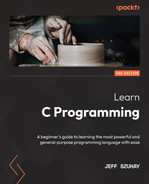Get started with writing simple programs in C while learning core programming concepts The foundation for many modern programming languages such as C++, C#, JavaScript, and Go, C is widely used as a system programming language as well as for embedded systems and high-performance computing. With this book, you'll be able to get up to speed with C in no time. The book takes you through basic programming concepts and shows you how to implement them in the C programming language. Throughout the book, you'll create and run programs that demonstrate essential C concepts, such as program structure with functions, control structures such as loops and conditional statements, and complex data structures. As you make progress, you'll get to grips with in-code documentation, testing, and validation methods. This new edition expands upon the use of enumerations, arrays, and additional C features, and provides two working programs based on the code used in the book. What's more, this book uses the method of intentional failure, where you'll develop a working program and then purposely break it to see what happens, thereby learning how to recognize possible mistakes when they happen. By the end of this C programming book, you'll have developed basic programming skills in C that can be easily applied to other programming languages and have gained a solid foundation for you to build on as a programmer. If you're an absolute beginner who has basic familiarity with operating a computer, this book will help you learn the most fundamental concepts and practices that you need to know to become a successful C programmer. If you're an experienced programmer, you'll find the full range of C syntax as well as common C idioms covered in the book useful.Key Features
Book Description
What you will learn
Who this book is for
Table of Contents
- Learn C Programming Second Edition
- Contributors
- About the author
- About the reviewers
- Preface
- Part 1: C Fundamentals
- Chapter 1:Running Hello, World!
- Chapter 2: Understanding Program Structure
- Chapter 3: Working with Basic Data Types
- Chapter 4: Using Variables and Assignments
- Chapter 5: Exploring Operators and Expressions
- Chapter 6: Exploring Conditional Program Flow
- Chapter 7: Exploring Loops and Iterations
- Chapter 8: Creating and Using Enumerations
- Part 2: Complex Data Types
- Chapter 9: Creating and Using Structures
- Chapter 10: Creating Custom Data Types with typedef
- Chapter 11: Working with Arrays
- Chapter 12: Working with Multi-Dimensional Arrays
- Chapter 13: Using Pointers
- Chapter 14: Understanding Arrays and Pointers
- Chapter 15: Working with Strings
- Chapter 16: Creating and Using More Complex Structures
- Part 3: Memory Manipulation
- Chapter 17: Understanding Memory Allocation and Lifetime
- Chapter 18: Using Dynamic Memory Allocation
- Part 4: Input and Output
- Chapter 19: Exploring Formatted Output
- Chapter 20: Getting Input from the Command Line
- Chapter 21: Exploring Formatted Input
- Chapter 22: Working with Files
- Chapter 23: Using File Input and File Output
- Part 5: Building Blocks for Larger Programs
- Chapter 24: Working with Multi-File Programs
- Chapter 25: Understanding Scope
- Chapter 26: Building Multi-File Programs with Make
- Chapter 27:Creating Two Card Programs
- Appendix
- Epilogue
- Assessments
- Other Books You May Enjoy
